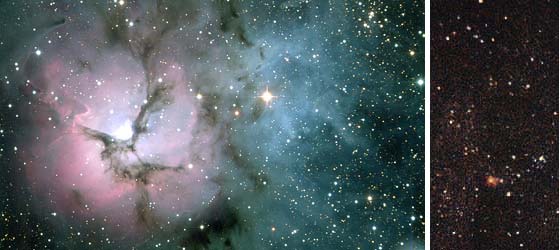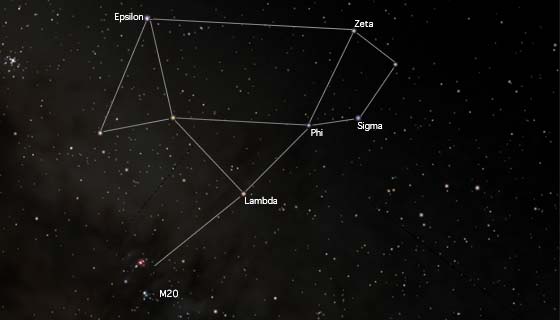
M20Here's some basic information about M20. Its a diffuse (emission and reflection) nebula in Sagittarius, also known as "the Trifid Nebula" or NGC 6514. The position is right ascension 18:02.6, declination -23:02, and the distance distance 5200 light years (this is uncertain). The magnitude is 9.0 (other magnituse estimates are probably higher due to the hot blue stars associated with the nebula). The apparent diameter is 28 arc minutes. Charles Messier discovered this object in 1764 but thought it was a cluster. Herschel discovered the fact it is a nebula in 1784. This object is a good example of the different colour of typical emission (red from excited hydrogen gas), reflection (reflected light from hot blue stars) and dark (black where light is being blocked by dust) nebulosity. Its a very famous and spectacular object in photographs taken with large telescopes but dimmer than many others and requires a dark sky to be fully appreciated. M20 is close to the bigger, brighter nebula M8 in Sagittarius near the tail of the Scorpion. The photo on the left is by a professional observatory. Note the colour of the reflection and emission parts and the distinctive dark lanes. On the right is a simple photo taken with a camera using 800 asa print film mounted piggy-back on a small telescope. 
To find M20 you need find the constellation Sagittarius. This constellation is often described as the teapot. You can see this shape (upside down for southern observers) in the diagram above. Even if you can't see a teapot, the quadrilateral and triangle shapes on either side are easy to find. If you have trouble finding Sagittarius, try starting from Scorpius and find Sagittarius near the scorpion's sting. The cluster on the left of the map near the top is M7 which is in Scorpius. After finding these shapes follow the line from Zeta to Phi to Lambda and contine in the same direction to find M8. M20 is about 1° away from M8 but much smaller and dimmer. A dark sky helps finding this object. |
![[Up]](../XuShared/Up2B.jpeg)
Comment on this page: Very Useful • Quite Useful • Useless or: View Results |
||||||||||||